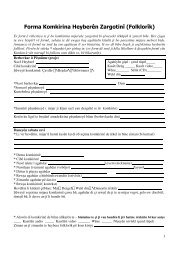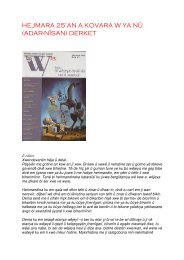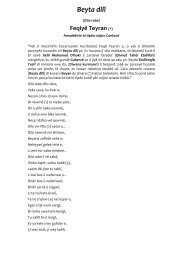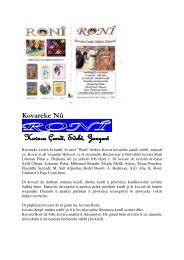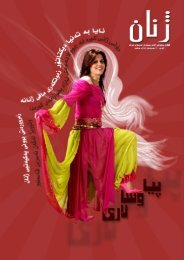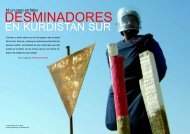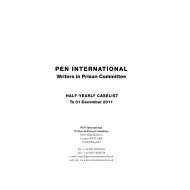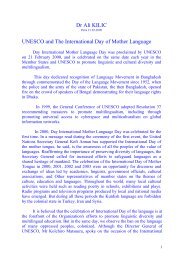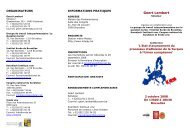The Kurds in Khorasan, North-east of Iran - Pen-Kurd
The Kurds in Khorasan, North-east of Iran - Pen-Kurd
The Kurds in Khorasan, North-east of Iran - Pen-Kurd
You also want an ePaper? Increase the reach of your titles
YUMPU automatically turns print PDFs into web optimized ePapers that Google loves.
marketed <strong>in</strong> the local bazzars (markets) <strong>of</strong> Qochan, Shirvan, and Bojnurd as well as <strong>in</strong>the great export<strong>in</strong>g market routes.<strong>The</strong> important city <strong>of</strong> Mashhad, long the capital <strong>of</strong> <strong>Khorasan</strong> Prov<strong>in</strong>ce, is on theimmediate <strong>east</strong>ern fr<strong>in</strong>ges <strong>of</strong> the <strong>Khorasan</strong>i <strong>Kurd</strong>ish region. To the west lies the city<strong>of</strong> M<strong>in</strong>oodasht, <strong>in</strong> the Prov<strong>in</strong>ce <strong>of</strong> Golistan <strong>in</strong> the way to Tehran.Thus the <strong>Khorasan</strong>i <strong>Kurd</strong>ish region has easy access to extensive markets, both forexport<strong>in</strong>g its own good and for import<strong>in</strong>g any technology or product it needed. <strong>The</strong>reare also many other ancient towns and cities dott<strong>in</strong>g the Revand Heights and itspiedmont. <strong>The</strong> modern Turkmen Capital <strong>of</strong> Ashkhabad (Ashgabat), for example, islocated on the northern slopes <strong>of</strong> the Revand, with its southern suburbs and city <strong>of</strong>Firuzeh as the <strong>Kurd</strong>ish <strong>in</strong>habitant area.<strong>The</strong> ma<strong>in</strong> trunk <strong>of</strong> the old Silk Road crossed the southern slopes <strong>of</strong> the Revand,pass<strong>in</strong>g through Mashhad on its way to Sabzivar, Tehran and beyond. A secondarytrunk l<strong>in</strong>e ran northwest from Mashhad through the major <strong>Kurd</strong>ish cities <strong>of</strong> Qochan,Shirvan, and Bojnurd. This northern route passed through the heartland <strong>of</strong> the<strong>Khorasan</strong>i <strong>Kurd</strong>ish region, but was always less important than the southern route dueto predation by Turkmen raiders from the thirteen century onward.Significant commerce nonetheless took place along the secondary l<strong>in</strong>e: the <strong><strong>Kurd</strong>s</strong> soldpass<strong>in</strong>g merchants such as commodities as dried foodstuff (rais<strong>in</strong>s, almonds, walnuts,apricots, peaches etc.), dairy products, meat, cereals, raw wool, f<strong>in</strong>ished woollens,cotton goods, rugs, kilims, and various other textiles.<strong>The</strong> Turko-Mongolian nomadic <strong>in</strong>flux, which began as a trickle <strong>in</strong> the sixth century,turned <strong>in</strong>to a destructive flood with the arrival <strong>of</strong> Genghiz-Khan’s Mongol armies <strong>in</strong>the thirteenth century. As a result, when the present <strong>Kurd</strong>ish population began toarrive <strong>in</strong> the early seventeenth century, this most fertile land <strong>in</strong> south-western Asiawas largely depopulated, its formerly prosperous urban / agricultural base destroyedby the Mongols.<strong>The</strong> major <strong>in</strong>flux <strong>of</strong> <strong><strong>Kurd</strong>s</strong> occurred <strong>in</strong> the early seventeenth century when they weredeported <strong>in</strong> masse from <strong>North</strong>ern part <strong>of</strong> <strong>Kurd</strong>istan <strong>in</strong> Turkey, by the Safavid K<strong>in</strong>gs <strong>of</strong>Persia, who forced them <strong>in</strong>to exile to northern <strong>Khorasan</strong> and beyond. <strong>The</strong>se arrivalsdid not cease until well <strong>in</strong>to the eighteenth century.<strong>The</strong> primary <strong>Kurd</strong>ish tribal confederacies <strong>in</strong> the region were the same as the orig<strong>in</strong>alfief divisions under the Safavids. <strong>The</strong> most important was the Za’faranlu, headed bythe house <strong>of</strong> Chemishgezek (Chamishgazak name <strong>in</strong> the <strong>Khorasan</strong>i <strong>Kurd</strong>ish regionwas changed to Za’afaranlu confederacy, about 1760 AD), whose last capital atQochan was the largest city and market <strong>in</strong> the <strong>Khorasan</strong>i <strong>Kurd</strong>ish region, but not anymore on today.Among the <strong>Kurd</strong>ish autonomous pr<strong>in</strong>cely houses <strong>of</strong> 16 th century, the Chamishgezek<strong>of</strong> Dersim, Malatiya, Elazig and Adiyaman <strong>in</strong> <strong>Kurd</strong>istan <strong>of</strong> Turkey were a strongaristocratic <strong>Kurd</strong>ish confederacy. After the Treaty <strong>of</strong> Zohab (between the OttomanEmpire which controlled Iraq, and Persia), 17 May 1639 AD, a relative calm3
descended upon <strong>Kurd</strong>istan and its autonomous pr<strong>in</strong>cipalities, to be broken relatively,but very harshly from 1722 AD onward.Autonomous <strong>Kurd</strong>ish pr<strong>in</strong>cipality <strong>of</strong> Chamishkazak or autonomous tribal chiefta<strong>in</strong>s <strong>of</strong>Chamishgazak <strong>in</strong> Turkey were completely f<strong>in</strong>ished after WWI. <strong>The</strong> traditional powerstructure was replaced by newly built state government, <strong>in</strong> l<strong>in</strong>e <strong>of</strong> <strong>Kurd</strong>ish <strong>in</strong>tegration.<strong>Kurd</strong>ish tribal aristocratic confederacies; Dr Mehrdad Izady, 1992, <strong>The</strong> <strong><strong>Kurd</strong>s</strong>; a concise handbook.<strong>The</strong> Za’faranlu <strong>Kurd</strong>ish confederacy had always controlled the largest area and theborders <strong>in</strong> north-west <strong>of</strong> <strong>Iran</strong>, and conta<strong>in</strong>ed the most member tribes, clans, andhouseholds.Rarely the Za’faranlu lost the political and military leadership <strong>of</strong> the <strong>Khorasan</strong>i<strong><strong>Kurd</strong>s</strong>. <strong>The</strong>y also dist<strong>in</strong>guished themselves through their military service to thePersian court, defend<strong>in</strong>g Persia’s north-<strong>east</strong>ern imperial borders aga<strong>in</strong>st <strong>in</strong>cursions byCentral Asiatic powers. It was the Za’faranlu generals and their <strong>Kurd</strong>ish cont<strong>in</strong>gencythat played a major role <strong>in</strong> the conquest <strong>of</strong> Mughal-India for the Persian monarchNader Shah <strong>in</strong> 1738, AD.<strong>The</strong> Kawanlu tribe (their headquarters was Radkan) became a constituent part (a verylarge one) <strong>of</strong> the Za’faranlu confederacy. In 1835 the Za’faranlu territory stretchedfrom the western environs <strong>of</strong> Mashhad to halfway between the towns <strong>of</strong> Shirvan andBojnurd.<strong>The</strong> Shadlu tribe were second <strong>in</strong> importance; their Capital was at Bojnurd (the formercity <strong>of</strong> Bozanyurd / Bozanjurd).4
<strong>The</strong> Qarachorlu tribe held the westernmost territory <strong>of</strong> the <strong>Khorasan</strong>i <strong>Kurd</strong>ish region,and were the most exposed to the Turkmen raiders. <strong>The</strong> town <strong>of</strong> Samalqan served astheir headquarters.<strong>The</strong>re were also several smaller confederacies at the time, <strong>in</strong>clud<strong>in</strong>g the Jelali, whoseterritory was the northern hill country fac<strong>in</strong>g the great Kara Kum desert <strong>in</strong> CentralAsia. <strong>The</strong> headquarters <strong>of</strong> Jelai tribe was Firoozeh.<strong>The</strong> <strong><strong>Kurd</strong>s</strong> who arrived <strong>in</strong> <strong>Khorasan</strong> were largely from the parts <strong>of</strong> <strong>North</strong>ern<strong>Kurd</strong>istan <strong>in</strong> South-<strong>east</strong>ern Turkey. And even today, about 4 centuries later, theyspeak various dialects <strong>of</strong> the <strong>North</strong> Kormanji language which still predom<strong>in</strong>atesamong the <strong><strong>Kurd</strong>s</strong> (<strong>in</strong> Turkey). <strong>The</strong> costumes and customs <strong>of</strong> <strong>Khorasan</strong>i <strong><strong>Kurd</strong>s</strong>resemble those <strong>of</strong> the <strong><strong>Kurd</strong>s</strong> <strong>in</strong> Turkey more closely than those <strong>of</strong> the other <strong><strong>Kurd</strong>s</strong>.<strong>The</strong> women wear high-heeled shoes and knee-high skirts, worn <strong>in</strong> layers and fittedwith white aprons or coloured waistcoats.<strong>The</strong>re can be little doubt that this was the fashion that <strong><strong>Kurd</strong>s</strong> wore <strong>in</strong> Anatolia fourhundred years ago, as no other groups <strong>in</strong> <strong>Khorasan</strong> wear anyth<strong>in</strong>g remotelyresembl<strong>in</strong>g this costume. <strong>The</strong> tenacity with which the <strong>Khorasan</strong>i <strong><strong>Kurd</strong>s</strong> havema<strong>in</strong>ta<strong>in</strong>ed their antique language, customs, culture and costumes strongly suggestsan equal tenacity <strong>in</strong> preserv<strong>in</strong>g their national <strong>Kurd</strong>ish and <strong>Iran</strong>ian traditions.<strong>Kurd</strong>ish tribes forced to move to <strong>Khorasan</strong> region / <strong>North</strong>-<strong>east</strong> <strong>of</strong> <strong>Iran</strong> dur<strong>in</strong>g SafavidDynasty about 1598 AD (or 1610 AD accord<strong>in</strong>g to some texts).By the beg<strong>in</strong>n<strong>in</strong>g <strong>of</strong> the 16 th century, the Shiite Safavid (<strong>Iran</strong>ian) Empire had emergedas a rival to the Ottoman Empire. <strong>The</strong> <strong><strong>Kurd</strong>s</strong> found themselves <strong>in</strong> the middle <strong>of</strong> theterritories claimed by the Sunni Turkic Ottomans and the Shiite Persian Safavids. <strong>The</strong>two empires fought at the Battle <strong>of</strong> Chaldiran <strong>in</strong> 1514 AD, where the Ottomansdefeated the Safavid Shah. <strong>The</strong> result <strong>of</strong> the battle established a boundary between thetwo empires that split the <strong><strong>Kurd</strong>s</strong> between Turkic and Persian empires.S<strong>in</strong>ce the 16 th Century, contiguous <strong>Kurd</strong>istan has been augmented by two large,detached enclaves <strong>of</strong> (ma<strong>in</strong>ly deported) <strong><strong>Kurd</strong>s</strong>. <strong>The</strong>se two enclaves are Central-Anatolian enclave (Konya Prov<strong>in</strong>ce, Turkey) and <strong>North</strong>-<strong>Khorasan</strong> enclave.S<strong>in</strong>ce World War I, <strong>Kurd</strong>istan has been divided among five sovereign states, with thelargest portions <strong>of</strong> <strong>Kurd</strong>istan territory <strong>in</strong> Turkey (%44) followed by <strong>Iran</strong> (%30), Iraq(%18), Syria (%6) and the former Soviet Union (%2). <strong>The</strong>se states have subdivided<strong>Kurd</strong>istan <strong>in</strong>to a myriad <strong>of</strong> adm<strong>in</strong>istrative units and prov<strong>in</strong>ces (<strong>Khorasan</strong> enclave isdivided among two prov<strong>in</strong>ces <strong>of</strong> <strong>North</strong>ern <strong>Khorasan</strong> and Razavi <strong>Khorasan</strong>).<strong>The</strong> Central-Anatolian enclave <strong>in</strong>cludes the area around the towns <strong>of</strong> Yunak,Haymana and Jahanbeyli / Jahanbegli, South <strong>of</strong> the Turkish capital <strong>of</strong> Ankara. Itextends <strong>in</strong>to the mounta<strong>in</strong>ous districts <strong>of</strong> <strong>North</strong>-Central Anatolia, where it is boundedby the towns <strong>of</strong> Tokat, Yozgat, polatli, Chorum and Amasya <strong>in</strong> the Yisilirmaq riverbasion. <strong>The</strong> fast expand<strong>in</strong>g <strong>North</strong>-Central Anatolian segment <strong>of</strong> the enclave now hasmore <strong><strong>Kurd</strong>s</strong> than the older segment <strong>in</strong> Central Anatolian.5
Of the two large detached enclaves <strong>of</strong> the <strong><strong>Kurd</strong>s</strong>, the one <strong>in</strong> <strong>Khorasan</strong> owes itsexistence to the deportations from <strong>North</strong>ern <strong>Kurd</strong>istan. Almost all the <strong>Kurd</strong>ishpopulation <strong>in</strong> <strong>Khorasan</strong> therefore speaks <strong>in</strong> Kurmanji, but centuries <strong>of</strong> exposure to theShiite community <strong>of</strong> <strong>Iran</strong> and the proximity to the Shiite holy city <strong>of</strong> Mashhad haverendered the community a mixture <strong>of</strong> Sunni and Shiite Muslims, with a pepper<strong>in</strong>g <strong>of</strong>Alewi (Alevi) adherents. It has had a far less tumultuous history <strong>in</strong> the past fewCenturies than the <strong>North</strong>ern <strong>Kurd</strong>istan most <strong>of</strong> its <strong>in</strong>habitants left beh<strong>in</strong>d. <strong>The</strong><strong>Khorasan</strong>i <strong>Kurd</strong>ish community preserves a tradition now lost to its orig<strong>in</strong>al home, astheir deportations co<strong>in</strong>cided with the beg<strong>in</strong>n<strong>in</strong>g <strong>of</strong> a susta<strong>in</strong>ed cataclysmic militaryravag<strong>in</strong>g <strong>of</strong> <strong>North</strong>ern <strong>Kurd</strong>istan by Persian and Ottoman Empires.About more than 60,000 <strong>Kurd</strong>ish families and tribes forced to move to <strong>Khorasan</strong>region / <strong>North</strong>-<strong>east</strong> <strong>of</strong> <strong>Iran</strong> (from <strong>North</strong>ern <strong>Kurd</strong>istan) dur<strong>in</strong>g Safavian Dynasty 1610AD, and the reason for that was purely political. <strong>The</strong>y were sent to <strong>Khorasan</strong> <strong>in</strong> orderto defend the prov<strong>in</strong>ce from attacks by Uzbek and Kazakhs warriors, and also toweaken the <strong><strong>Kurd</strong>s</strong> <strong>in</strong> <strong>Kurd</strong>istan which their democratic demands were not <strong>in</strong> l<strong>in</strong>e <strong>of</strong>rul<strong>in</strong>g tyrant.<strong>Kurd</strong>ish dislocation: Dr Mehrdad Izady, <strong>The</strong> <strong><strong>Kurd</strong>s</strong>; a concise handbook, 1992.<strong><strong>Kurd</strong>s</strong> who are considered to be very determ<strong>in</strong>ed and j<strong>in</strong>goistic people by nature didthe job and pushed the warriors back to where they belong to and consequently thepolitic <strong>of</strong> Shah abbas Safavi had worked to perfection by us<strong>in</strong>g <strong><strong>Kurd</strong>s</strong> <strong>in</strong> order topreserve the <strong>in</strong>tegrity <strong>of</strong> the country and his rul<strong>in</strong>g at the time. <strong>The</strong>refore, <strong>Khorasan</strong>i<strong><strong>Kurd</strong>s</strong> have rescued <strong>Iran</strong> from foreign occupation and cont<strong>in</strong>ued to do so till today.6
Currently about more than 1.7 million <strong><strong>Kurd</strong>s</strong> are liv<strong>in</strong>g <strong>in</strong> <strong>Khorasan</strong> (60% <strong>in</strong> villages,35% <strong>in</strong> Cities and 5% as Nomadic migrants people / koçberî), the most majority <strong>of</strong>them talks <strong>in</strong> Kormanji dialect <strong>of</strong> <strong>Kurd</strong>ish language.In <strong>North</strong>ern <strong>Khorasan</strong> (with total population <strong>of</strong> 850.000); the population <strong>of</strong> <strong><strong>Kurd</strong>s</strong> isabout 70% <strong>of</strong> the Prov<strong>in</strong>ce (about 595.000), Turks (who are the remnant <strong>of</strong> Uzbeksand Kazaks <strong>in</strong>vaders <strong>of</strong> <strong>Iran</strong>, 16 Centaury) about 18% <strong>of</strong> the Prov<strong>in</strong>ce (about153.000), Fars about 7% <strong>of</strong> the Prov<strong>in</strong>ce (about 60.000), and Turkmen is about 5% <strong>of</strong>the Prov<strong>in</strong>ce (about 45.000) who are <strong>in</strong> Jargalan rural district / border withTurkmenistan. About 600.000 <strong><strong>Kurd</strong>s</strong> live <strong>in</strong> the west and <strong>North</strong>west <strong>of</strong> the Razavi<strong>Khorasan</strong> Prov<strong>in</strong>ce.About 13 to 15% <strong>of</strong> Mashhad population (Capital <strong>of</strong> Razavi Prov<strong>in</strong>ce, with thepopulation <strong>of</strong> about 3.000.000) is <strong><strong>Kurd</strong>s</strong>, which <strong>in</strong> figure becomes about 400.000 asestimates. <strong>The</strong> total population <strong>of</strong> <strong><strong>Kurd</strong>s</strong> <strong>in</strong> <strong>Khorasan</strong> estimates slightly more than 1.5million.<strong>The</strong> ma<strong>in</strong> <strong>Kurd</strong>ish <strong>in</strong>habited cities <strong>in</strong> <strong>Khorasan</strong> are: Quchan, Shirvan, Esfarayen,Bojnurd, Kalat, La<strong>in</strong>, Daregaz & dorungar, Faroj, Bajgiran, Chenaran, Ashkhane,Mane-u-Similqan, Joveyn, Raz, Radkan, Sabzivar (rural district <strong>in</strong> northern part),Sarakhs, also there is a large number <strong>of</strong> <strong><strong>Kurd</strong>s</strong> who live <strong>in</strong> Mashhad.<strong>Khorasan</strong>i <strong>Kurd</strong>ish ma<strong>in</strong> tribes and their <strong>in</strong>habited regions and cities.7
It is needless to say that the lack <strong>of</strong> state <strong>in</strong>vestment has left the area <strong>in</strong> destitution,undeveloped with no prosperity; about 23% <strong>of</strong> <strong><strong>Kurd</strong>s</strong> <strong>in</strong> <strong>Khorasan</strong> are completelyilliterate especially nomadic immigrants.<strong>Khorasan</strong>i <strong><strong>Kurd</strong>s</strong> are not allowed to be educated <strong>in</strong> their own mother language, andthe regional rul<strong>in</strong>g <strong>of</strong>ficialdom is not from khorasani <strong><strong>Kurd</strong>s</strong>. <strong>The</strong>y are not allowed tohave any organised <strong>Kurd</strong>ish political, cultural, educational and civil centres or forumsto improve and modernise their culture, language and social affairs which is theirlogical basic civil rights, <strong>in</strong> <strong>Iran</strong>. <strong>Khorasan</strong>i <strong><strong>Kurd</strong>s</strong> does not have any radio or TVstation <strong>in</strong> their language. <strong>Kurd</strong>ish leaders, <strong>in</strong>tellectuals and writers are prosecuted,<strong>in</strong>sulted, oppressed and jailed.<strong>Kurd</strong>ish tribes <strong>in</strong> <strong>Khorasan</strong> are mostly settled <strong>in</strong> regional cities and villages, althoughthere still are some pastoralist migrat<strong>in</strong>g nomads. Those who are settled <strong>in</strong> the villageswork <strong>in</strong> agricultural (sugar beets, cotton, cereals, vegetables, by-product such as hayetc.), garden<strong>in</strong>g (fruits, grapes, nut trees etc.) and livestock economy. Those who live<strong>in</strong> the cities <strong>in</strong>volved <strong>in</strong> public and private sectors, and <strong>in</strong> market trad<strong>in</strong>g society. <strong>The</strong>average rate <strong>of</strong> state employment <strong>in</strong> <strong>Khorasan</strong>i <strong>Kurd</strong>ish region estimates about 15%respectively.Pastoralist herd<strong>in</strong>g especially <strong>in</strong> mounta<strong>in</strong>s and the steep slops is a way <strong>of</strong> traditionaleconomy yet. <strong>The</strong> most important livestock <strong>of</strong> <strong>Kurd</strong>ish tribes are sheep and to a lesserextent goats and cattle. Animal products <strong>in</strong>clude; meat, milk, wool, leather and dairyproducts such as; cheeses, yogurt, curds, buttermilk and butter. <strong>Kurd</strong>ish handmaderugs, kelims, carpets and other textiles are still produced <strong>in</strong> relatively large quantities.<strong>The</strong>re is not that traditional tribal power structure (see later) anymore by hav<strong>in</strong>g amodern state govern<strong>in</strong>g and economy system <strong>in</strong> <strong>Iran</strong>. <strong>The</strong> most majority <strong>of</strong> <strong>Khorasan</strong>i<strong>Kurd</strong>ish <strong>in</strong>tellectuals want to preserve their culture, language and traditions with<strong>in</strong> aplural society by a modern rul<strong>in</strong>g style based on UN human rights framework <strong>in</strong> thestate <strong>of</strong> <strong>Iran</strong>.Nowadays, as <strong>in</strong>dustrialised age with the high <strong>in</strong>formation technology, transportationsand communications, there is not that tribes’ chiefta<strong>in</strong>s left <strong>in</strong> <strong>Kurd</strong>ish region <strong>of</strong><strong>Khorasan</strong> and by this; the collection <strong>of</strong> revenue and manpower <strong>in</strong> aim <strong>of</strong> govern<strong>in</strong>gthe tribes, rema<strong>in</strong>s too weak. Individualism and the values <strong>of</strong> democracy andpluralism are gett<strong>in</strong>g stronger amongst young generations day by day, although thereis no that state <strong>in</strong>vestment <strong>in</strong> the region. Infrastructurally, khorasani <strong>Kurd</strong>ish region isthe l<strong>east</strong> developed, the overall level <strong>of</strong> modern improvements rema<strong>in</strong>s below thenational averages, <strong>in</strong> comparison to other prov<strong>in</strong>ces such as Tehran and Esfahan.<strong>Khorasan</strong>i <strong>Kurd</strong>ish region has two sites <strong>of</strong> oil reserves as natural resources; one is <strong>in</strong>Quchan and the other one <strong>in</strong> Raz. <strong>The</strong>re is a Gas field <strong>in</strong> Khangiran, Sarakhs. <strong>The</strong>seoil reserves are not <strong>in</strong> use yet as there is no oil ref<strong>in</strong>ement there, although it might beuseful for the local petrochemical factory <strong>in</strong> Bojnurd.Women are allowed some freedom <strong>in</strong> compare to the other people for example Baluchor Arabs. <strong>Kurd</strong>ish nomadic women are semi-unveiled, except <strong>in</strong> cities and large towns8
that veils are frequently be<strong>in</strong>g forced on <strong>Kurd</strong>ish women. Nomadic <strong>Kurd</strong>ish womenand even those <strong>of</strong> <strong>in</strong> villages are not <strong>in</strong> that cautious degree to hide themselves butmost <strong>of</strong> the hard manual labour and children car<strong>in</strong>g falls upon them. Nowadays, <strong>in</strong> theurban areas, <strong>Khorasan</strong>i <strong>Kurd</strong>ish women are active <strong>in</strong> education, cultural and civilaffaires.<strong>The</strong> most majority <strong>of</strong> khorasani <strong><strong>Kurd</strong>s</strong> are Shia Muslim. <strong>The</strong> subject <strong>of</strong> religion israrely used by the <strong><strong>Kurd</strong>s</strong> to create literature and ceremonies except by the state localrulers. <strong>Khorasan</strong>i <strong><strong>Kurd</strong>s</strong> are not a religious people <strong>in</strong> general, which is not <strong>in</strong> l<strong>in</strong>e <strong>of</strong>the state rulers. <strong>Khorasan</strong>i <strong><strong>Kurd</strong>s</strong> are brave and famous <strong>in</strong> hospitality and k<strong>in</strong>dnessespecially about outsiders’ guests.<strong>Kurd</strong>ish people <strong>in</strong> the region mostly suffers from zoonoses diseases such as;Brucellosis, Tuberculosis, Salmonellosis and Parasitic <strong>in</strong>festation. Rheumaticproblems <strong>in</strong> adults and malnutrition <strong>in</strong> children are common. Health services areavailable <strong>in</strong> a limited form <strong>in</strong> local cl<strong>in</strong>ics and health centres especially <strong>in</strong> ma<strong>in</strong>villages <strong>in</strong> the routes <strong>of</strong> immigrant tribes between their seasonal encampments.<strong>The</strong> role <strong>of</strong> tribes as preventive health care is seldom. <strong>The</strong> traditional medicationssuch as us<strong>in</strong>g especial regional plants as herbal medications are rarely used, especially<strong>in</strong> the summer or w<strong>in</strong>ter camps. <strong>The</strong> Avian flu and Anthrax has seen <strong>in</strong> the region, for<strong>in</strong>stance the Anthrax was seen <strong>in</strong> the village <strong>of</strong> Cherri suburban <strong>of</strong> Faruj, 1996, thatwas covered by local health services.New year festival “ Newroz ” on 21 st March is respected between <strong>Khorasan</strong>i <strong><strong>Kurd</strong>s</strong>, asit is identical to state and national festivals, <strong>in</strong> despite <strong>of</strong> ideological religious rulersreluctance. Marriages and funerals are important events. Gifts are exchanged betweenthe wedd<strong>in</strong>g families, and after marr<strong>in</strong>g ceremonies the couple receive more presentsfor their new lives.<strong>The</strong> area around Lake Van <strong>in</strong> Turkey, as <strong>Kurd</strong>ish <strong>in</strong>habited regions for thousands <strong>of</strong>years has historically been one <strong>of</strong> political <strong>in</strong>stability as a frontier region betweenmajor local political entities. After the Turkic <strong>in</strong>vasions <strong>of</strong> the 11 th century AD therewas a brief unity <strong>of</strong> Anatolia and <strong>Iran</strong> under Seljuk, dur<strong>in</strong>g which there was thejunction <strong>of</strong> the major <strong>east</strong>-west and north-south trade routes. Follow<strong>in</strong>g <strong>of</strong> the breakup <strong>of</strong> the Seljuk Empire the region became a part <strong>of</strong> the Akkoyonlu Empire (Safavid),itself a nomad dynasty.Subsequently it formed an unstable buffer zone between the Ottoman Empire andsuccessive Persian dynasties, becom<strong>in</strong>g progressively depopulated dur<strong>in</strong>g theconflicts <strong>of</strong> the Safavid period. Although migratory <strong>Kurd</strong>ish tribes were undoubtedlypresent <strong>in</strong> earlier times, the unstable conditions <strong>of</strong> the period follow<strong>in</strong>g 1,600 ADbrought about the strengthen<strong>in</strong>g <strong>of</strong> tribal affiliations and an expansion <strong>of</strong> Nomadicactivity. <strong>The</strong> historical orig<strong>in</strong>s <strong>of</strong> the <strong>Khorasan</strong>i <strong><strong>Kurd</strong>s</strong> are around Lake Van towardthe city <strong>of</strong> Adiyaman <strong>in</strong> south-<strong>east</strong> Turkey on today.<strong>The</strong> last chief <strong>of</strong> Za’afaranlu was Shahpur Negahban died <strong>in</strong> 1960. After the landreform <strong>of</strong> 1962 AD, the most <strong>of</strong> the chiefs <strong>of</strong> settled clans severed relations with theirtribes. In 1979, at the outbreak <strong>of</strong> the Islamic revolution, their only role was that <strong>of</strong>9
mediator between families, or between nomads and the adm<strong>in</strong>istration. <strong>The</strong>y wereconsultants rather than chiefs <strong>of</strong> a clan or tribe.Nowadays the immigrant <strong><strong>Kurd</strong>s</strong> <strong>in</strong> the <strong>North</strong> <strong>of</strong> <strong>Khorasan</strong> spend their summer <strong>in</strong> themounta<strong>in</strong> pastures <strong>of</strong> Hezarmasjed, B<strong>in</strong>alud and Shahjahan and their w<strong>in</strong>ter <strong>in</strong> thepla<strong>in</strong>s <strong>of</strong> Sarakhs, Pasakuh and Daregaz and <strong>in</strong> the Turkmen steppe as far <strong>east</strong> asChat. <strong>The</strong>y have spread right across the north <strong>of</strong> <strong>Khorasan</strong> from <strong>east</strong> to west and evenoccupy part <strong>of</strong> <strong>east</strong>ern Turkmen steppe.Historically, areas like Sarakhs, Pasakuh and Daregaz had been thought <strong>of</strong> as <strong>Kurd</strong>ishw<strong>in</strong>ter quarters ever s<strong>in</strong>ce the reign <strong>of</strong> Shah Abbas I. Marava-tapah (72 mile, <strong>North</strong>west<strong>of</strong> Bojnurd) on the southern bank <strong>of</strong> the Atrak River is also the w<strong>in</strong>ter quarters <strong>of</strong>the <strong><strong>Kurd</strong>s</strong>. Some time there has been conflicts between the Guglan clan <strong>of</strong> Turkmenand the nomadic <strong><strong>Kurd</strong>s</strong> <strong>of</strong> Bojnurd. <strong>The</strong> <strong>Kurd</strong>ish claim to have been us<strong>in</strong>g thepasturelands <strong>in</strong> the Turkmen steppe for the last 100 years is a reliable one.<strong>The</strong> seasonal immigration route from Shirvan and Quchan (summer camps) toMaraveh-tapeh (w<strong>in</strong>ter camp) is about 400 km, and from Quchan (summer camp) toSarakhs (w<strong>in</strong>ter camp) is about 200 km.<strong>Kurd</strong>ish migratory tribes: seasonal encampments’ routes and dest<strong>in</strong>ation <strong>in</strong> <strong>Khorasan</strong>, <strong>Iran</strong>.Those clans <strong>of</strong> <strong><strong>Kurd</strong>s</strong> who spent the w<strong>in</strong>ter <strong>in</strong> the graz<strong>in</strong>g around Daregaz usuallyhave their summer pastures <strong>in</strong> the mounta<strong>in</strong>s <strong>of</strong> Hazarmasjed, and those who spent thew<strong>in</strong>ter <strong>in</strong> the Turkmen-sahra region, <strong>in</strong> the summer migrate to the mounta<strong>in</strong>s <strong>of</strong>Shahjahan.10
<strong>The</strong> summer encampments are divided as follows: about 42% <strong>in</strong> the mounta<strong>in</strong>s <strong>of</strong>Hazarmasjed, about 48% <strong>in</strong> the mounta<strong>in</strong>s <strong>of</strong> Shahjahan and 10% <strong>in</strong> the pastures <strong>of</strong>B<strong>in</strong>alud. This has been <strong>in</strong>terpreted as demonstrat<strong>in</strong>g that Shahjahan is more attractiveas a summer camp<strong>in</strong>g ground than Hazarmasjed, the earliest centre for the <strong><strong>Kurd</strong>s</strong> <strong>in</strong>northern <strong>Khorasan</strong>.<strong>The</strong> great majority <strong>of</strong> those spend<strong>in</strong>g their summers <strong>in</strong> Hazarmasjed belong to thesemi-nomadic <strong>Kurd</strong>ish tribes and their w<strong>in</strong>ter quarters are more widely dispersed thanthe summer quarters.In w<strong>in</strong>ter, the encampments <strong>of</strong> the nomads <strong>in</strong> the north <strong>of</strong> <strong>Khorasan</strong> are located <strong>in</strong>five different areas; Turkmen Sahra 44.5% , <strong>The</strong> Sarakhs region 44% , <strong>The</strong> Daregazarea 5.5%, whilst Sabzivar and Esfarayen only attract 4.5%, Maneh (district besidethe Atrak River, which is <strong>in</strong> halfway between Shahjahan and Turkmen Sahra) about1.5%.Seasonal encampments <strong>of</strong> immigrant <strong><strong>Kurd</strong>s</strong> <strong>in</strong> <strong>Khorasan</strong>, <strong>Iran</strong>.<strong>The</strong>re is no any census that records the ethnic orig<strong>in</strong>s <strong>of</strong> the <strong>in</strong>habitants <strong>of</strong> <strong>Khorasan</strong>.<strong>The</strong>refore, it is impossible to estimate the exact population <strong>of</strong> immigrant <strong><strong>Kurd</strong>s</strong>present <strong>in</strong> the total population. For the variety reasons the national census <strong>in</strong> <strong>Iran</strong> isnot trusted as a precise and democratic one, although it is not cover<strong>in</strong>g the issues <strong>of</strong>m<strong>in</strong>orities. Dur<strong>in</strong>g the Shah’s regime the extent <strong>of</strong> the nomadic population andnomadism <strong>in</strong> general, was concealed as far as possible. <strong>The</strong> number <strong>of</strong> <strong>Kurd</strong>ishnomads <strong>in</strong> <strong>Khorasan</strong> estimate at around 120,000.11
<strong>Khorasan</strong>i <strong>Kurd</strong>ish traditional social structure and network<strong>in</strong>g power’s ranks wereorganised accord<strong>in</strong>g to the follow<strong>in</strong>g hierarchy:Social Structure …………....…>……………. Network Power1- Greater tribe (Confederacy)…>……….…….ill-khan (Mir)2- Tribe (ill)……………….……>……………..ill-Beg (Khan)3- Clan (Tayfeh)….………….…>…………..…Beg (Kad-khoda)4- Sect (Toper)………………….>………..……Rih-gewir (senior person)5- Camp group (Obe / B<strong>in</strong>e)……>…………..…Sar-obe (Camp chief)6- Family (unit / tent /quw<strong>in</strong>)......>………….… Sare-male (family head)<strong>The</strong> only major <strong>Kurd</strong>ish confederacy <strong>in</strong> <strong>Khorasan</strong> was Chamishgazak confederacywhich its name was changed to Za’afaranlu confederacy, about 1760 AD (made up <strong>of</strong>about 32 tribes; 8 major plus 24 small tribes). Usually about 4 to 8 unit make an Obedepends on their livestock size.Ill-khan as head <strong>of</strong> <strong>Kurd</strong>ish confederacy had a strong political power and was <strong>in</strong>relat<strong>in</strong>g to central government. Ill-khan also was responsible for protect<strong>in</strong>g the Stateborders from warriors. Confederacy was a comb<strong>in</strong>e <strong>of</strong> some tribes as wider politicalorganization; an aff<strong>in</strong>ity was recognized with adjacent tribes such as the Kawanlu,Topkanlu, Kikanlu, Jalai, Maliwanlu and Qarachorlu as Za’afaranlu confederacy.<strong>The</strong>se political power rank<strong>in</strong>gs and pr<strong>in</strong>ciple were destroyed <strong>in</strong> Reza-shah time, 1920AD, wish<strong>in</strong>g to control, reorganize or disband nomad tribes.Tribal names are generally composed <strong>of</strong> an orig<strong>in</strong> followed by the suffix " Li " or " Lu" which implies " <strong>of</strong> " or " belong<strong>in</strong>g to ". Thus a tribe may acquire its name by afound<strong>in</strong>g father’s name, for <strong>in</strong>stance; the name Kavanlu (Kowanli / Kawanlu) comesafter Kava / Kawe, which is the name <strong>of</strong> Kava the blacksmith (621 BC) who is thecreator <strong>of</strong> Newroz and its fire festival celebration, 21st March on every years untiltoday.Alternatively some characteristic or nick name, for <strong>in</strong>stance such as Pahlavanlu (verystrong or athlete) might be rife <strong>in</strong>to the tribal name structure simply reflects the factthat tribal and village designations are frequently <strong>in</strong>terchangeable.Nowadays, the tribes <strong>in</strong> <strong>Khorasan</strong> are not hierarchically organised, unlike <strong>in</strong> formerone that each tribe had an organised structure with a head chief. <strong>Khorasan</strong>i <strong>Kurd</strong>ishtribes and clans are listed with their locations as follow<strong>in</strong>g. Remarks <strong>in</strong> parentheses<strong>in</strong>clude alternative tribal name. <strong>The</strong> language <strong>of</strong> them is <strong>Kurd</strong>ish dialect <strong>of</strong> Kormanji.12
<strong>Kurd</strong>ish tribes; Dr Mehrdad Izady, <strong>The</strong> <strong><strong>Kurd</strong>s</strong>; a concise handbook, 1992.<strong>Kurd</strong>ish tribes <strong>in</strong> <strong>Khorasan</strong>:1- Artekanlu; a clan from Amarlu tribe who lives <strong>in</strong> artiyan village closed toMohamad-Abad <strong>of</strong> Daregaz and villages <strong>in</strong> rural district <strong>of</strong> Marusk suburbs <strong>of</strong>Neyshabur.2- Alanlu; A clan from Shadlu tribe who lives <strong>in</strong> villages <strong>in</strong> countryside <strong>of</strong>Bojnurd, such as; Garivan, Nystanah, Firuzeh, Mahestan, and also some othervillages <strong>in</strong> Maneh va Samalqan and Jajarm.3- Amiranlu (Sheykhamiranlu); a clan from Greater tribe <strong>of</strong> Za’afaranlu wholives <strong>in</strong> Shirvan and <strong>North</strong> <strong>of</strong> Esfarayen.4- Ulashlu; A clan from Sivkanlu (sivirkanlu) tribe who lives <strong>in</strong> villages such as;Ghale-safa, Ghosh-ghale, Titkanlu, and also <strong>in</strong> Shirvan, Quchan and Mashhad.5- Bachvanlu; A clan from Qachkanlu tribe, subdivision <strong>of</strong> Kavanlu tribe, wholives <strong>in</strong> villages such as; Palkan, Jolfa and Borj-ghale (Toranlo) <strong>in</strong> countryside<strong>of</strong> Daregaz. Some <strong>of</strong> Qachkanlu tribe live <strong>in</strong> rural district <strong>of</strong> Dolat-khane, <strong>in</strong>villages such as; Fath-abad and Qachkanlo <strong>in</strong> countryside <strong>of</strong> Quchan.6- Bachiyanlu / Bachvanlu; A clan from Greater tribe <strong>of</strong> Za’afaranlu who lives <strong>in</strong>Ashkhaneh, rural district <strong>of</strong> Dolat-khaneh suburbs <strong>of</strong> Quchan, villages <strong>of</strong>Baba-cheshmeh suburbs <strong>of</strong> Esfarayen.7- Badelanlu (Bahadoranlu); this clan lives <strong>in</strong> villages such as; Alaghe-jonban,Kalateh-gol, Marghzar suburbs <strong>of</strong> Quchan. Some <strong>of</strong> them live <strong>in</strong> Nokhandan13
<strong>of</strong> Daregaz and Golmakan. <strong>The</strong> last leader <strong>of</strong> this clan was Taj-mohamadkhan.8- Bagiarlu; A clan from Amarlu tribe who live <strong>in</strong> the village <strong>of</strong> Amarlo <strong>in</strong>countryside <strong>of</strong> Neyshabur.9- Balkanlu (Palkanlu); This clan lives <strong>in</strong> village <strong>of</strong> Jeristan <strong>in</strong> countryside <strong>of</strong>Shirvan, Palikanlo S<strong>of</strong>la & Oliya <strong>in</strong> Nokhandan rural district <strong>of</strong> Daregaz.10- Badranlu; A clan from Greater tribe <strong>of</strong> Za’afaranlu who lives <strong>in</strong> villages suchas; Badiranlo and Heydar-abad <strong>in</strong> countryside <strong>of</strong> Bojnurd.11- Barivanlu (Birivanlu / Barimanlu); a clan from Greater tribe <strong>of</strong> Za’afaranluwho travel between Daregaz and Sarakhs (w<strong>in</strong>ter camps) and B<strong>in</strong>alud(summer camps). Some <strong>of</strong> them setteled <strong>in</strong> Mashhad, Kalat and Daregaz.12- Boqanlu; A clan from Shadlu tribe who lives <strong>in</strong> village <strong>of</strong> Ali-abad <strong>in</strong>countryside <strong>of</strong> Bojnurd.13- Bovanlu; A sect from Sivikanlu clan <strong>of</strong> Kikanlu tribe, who lives <strong>in</strong> villagessuch as; Ghale-safa, Ghosh-ghale, Titkanlo, and cities such as Shirvan,Quchan and Mashhad.14- Burzanlu (Barezanlu); a clan from Greater tribe <strong>of</strong> Za’afaranlu who lives <strong>in</strong>villages such as; Burzanlo and Heydar-abad <strong>in</strong> countryside <strong>of</strong> Bojnurd.15- Buzanlu; aclan from Greater tribe <strong>of</strong> Za’afaranlu who lives <strong>in</strong> village <strong>of</strong>Khesht <strong>in</strong> countryside <strong>of</strong> Kalat.16- Bicharanlu (Bakran / Shamali / shamlu); a clan from Kikanlu tribe who lives<strong>in</strong> rural district <strong>of</strong> jiristan <strong>in</strong> countryside <strong>of</strong> Shirvan, villages such as;Honameh, Ghale-hasan, Gadogan, Gholanlu, Ghale-naqdo, Ghale-dolu,Kalateh-bali.17- Pazuki; A clan from za’afaranlu tribe who lives <strong>in</strong> villages such as; Kalteh-Habashi, Mohamad-abad, Shams-abad, Char-borj, Kalate-badilu <strong>in</strong> thecountryside <strong>of</strong> Golmakan, which is closed to Mashhad.18- Payi; A clan from Amarlu tribe who lives <strong>in</strong> rural district <strong>of</strong> Marusk <strong>in</strong>countryside <strong>of</strong> Neyshabur.19- Pahlavanlu; this clan is from Greater Za’afaranlu tribe who lives <strong>in</strong> villagessuch as Dor-badam, Emam-qoli an Bardar <strong>in</strong> countryside <strong>of</strong> Bajgiran, andsome <strong>of</strong> them live <strong>in</strong> Shirvan and Bojnurd.20- Piranlu; A clan from Greater Za’afaranlu tribe who lives <strong>in</strong> rural district <strong>of</strong>Mezerj <strong>in</strong> countryside <strong>of</strong> Quchan.21- Pirvadanlu; A sect from Bicharanlu clan <strong>of</strong> za’afaranlu tribe who lives <strong>in</strong>village <strong>of</strong> Pirvadanlo.14
22- Tarsanlu (Torsanlu); a clan from Kavanlu tribe who lives <strong>in</strong> village <strong>of</strong>Arghoon-shah <strong>in</strong> countryside <strong>of</strong> Kalat. Some <strong>of</strong> them setteled <strong>in</strong> Chenaran andMashhad.23- Tupkanlu (Topkanlu); this tribe lives <strong>in</strong> Quchan, Shirvan, Esfarayen, Mashhadand <strong>in</strong> <strong>North</strong>ern region <strong>of</strong> Neyshabur. Some <strong>of</strong> them travel between summercamps (Akhlamad, Kuh-Klidar, <strong>in</strong> south-<strong>east</strong>ern <strong>of</strong> Quchan) and w<strong>in</strong>ter camps(Sarakhs and Mozduran). <strong>The</strong> sects <strong>of</strong> this tribes are; Karikanlo, Kalmishi,Farhad-khani, Latifi, Torabi, Shir-ghazi, Agha-mohamad-khani, Samkani,Zeynali, and Samimi.24- Turanlu; A clan from za’afaranlu tribe who livez <strong>in</strong> villages <strong>of</strong> Turanlo andBorj-ghale suburbs <strong>of</strong> Nokhandan. Some <strong>of</strong> them travel between summercamps (Kismar) and w<strong>in</strong>ter camps (Haji).25- Titkanlu; A sect from Badilu clan who lives <strong>in</strong> village <strong>of</strong> Titkan, <strong>North</strong>western<strong>of</strong> Quchan.26- Jalali; A tribe who lives <strong>in</strong> villages such as Firuzeh, Gholjogh suburbs <strong>of</strong>Shirvan, and village <strong>of</strong> Kuran suburbs <strong>of</strong> Faruj. Some <strong>of</strong> them live <strong>in</strong> Bojnurdand Shirvan. <strong>The</strong> most majority <strong>of</strong> them live <strong>in</strong> the cities <strong>of</strong> Ashghabad andFiruzeh <strong>in</strong> Tukmenistan State / just over the border. <strong>The</strong> clans <strong>of</strong> Jalali tribeare; Kopniklu, Kordikanlu, Kargarlu, Kurkanlu, Kuranlu, Kusanlu (Kuse),Guran.27- Jozanlu (Jawzanlu); this clan live <strong>in</strong> village <strong>of</strong> Jawzan suburbs <strong>of</strong> Quchan.28- Chapanlu; A clan from Shadlu tribe who lives <strong>in</strong> villages <strong>in</strong> suburbs <strong>of</strong>Bojnurd, such as; Garivan, Nystanah, Firuzeh, Mahestan, and also some othervillages <strong>in</strong> Maneh va Samalqan.29- Chakhmaqlu; A clan from Shadlu tribe who lives <strong>in</strong> villages <strong>in</strong> suburbs <strong>of</strong>Bojnurd, such as; Garivan, Nystanah, Firuzeh, Mahestan, and also some othervillages <strong>in</strong> Maneh va Samalqan.30- Chakanelu; this clan lives <strong>in</strong> village <strong>of</strong> Chakaneh and Sarvelayat as suburbs <strong>of</strong>Neyshabur. Some live <strong>in</strong> Nokhandan, suburbs <strong>of</strong> Daregaz.31- Hamzikanlu(Hazoanlu); A clan from Kikanlu tribe who live <strong>in</strong> villages suchas; Hamzekanlu bala, Hamzekanlu pay<strong>in</strong> suburbs <strong>of</strong> Quchan, Hamzekansuburbs <strong>of</strong> Bojnurd, rest <strong>of</strong> them live <strong>in</strong> village <strong>in</strong> countryside <strong>of</strong> Golmakan.Hazo is related to a place <strong>in</strong> Turkey as their orig<strong>in</strong>.32- Khakhiyanlu; this clan lives <strong>in</strong> village <strong>of</strong> Khakhiyan suburbs <strong>of</strong> Nokhandan,Daregaz.33- Kheder (Xidir); a clan from Kikanlu who live village <strong>of</strong> Khedir suburbs <strong>of</strong>Shirvan.15
34- Khosravanlu; A clan from Pahlavanlu tribe who live <strong>in</strong> villages such as Partansuburbs <strong>of</strong> Esfarayen, Khosraviye suburbs <strong>of</strong> Faruj.35- Khallanlu; A sect from Khalikanlu clan <strong>of</strong> Kavanlu tribe who live <strong>in</strong> villagessuch as; Khalikanlu <strong>in</strong> rural district <strong>of</strong> Jaffar-abad suburbs <strong>of</strong> Quchan, khalanosuburbs <strong>of</strong> Daregaz.36- Khomartash (Xurtash); a sect from Za’afaranlu tribe who live <strong>in</strong> village <strong>of</strong>Khomartash <strong>in</strong> <strong>North</strong> <strong>of</strong> Quchan (6 km).37- Davanlu; a clan from za’afaranlu tribe who live <strong>in</strong> Jajarm <strong>of</strong> Bojnurd.38- Dudanlu; this clan live <strong>in</strong> village <strong>of</strong> Dudanlo <strong>in</strong> the valley <strong>of</strong> Shakar-absuburbs <strong>of</strong> Daregaz.39- Duleshanlu; a sect from Bachvanlu clan <strong>of</strong> Kavanlu tribe who live <strong>in</strong> village <strong>of</strong>Duleshanlu suburbs <strong>of</strong> Nokhandan, Daregaz.40- Diranlu; A clan from Shadlu tribe who lives <strong>in</strong> villages <strong>in</strong> suburbs <strong>of</strong> Bojnurd,such as; Garivan, Nystanah, Firuzeh, Mahestan, and also some other villages<strong>in</strong> Maneh va Samalqan and Jajarm.41- Dirqanlu; A clan from Shadlu tribe who lives <strong>in</strong> villages <strong>in</strong> suburbs <strong>of</strong>Bojnurd, such as; Garivan, Nystanah, Firuzeh, Mahestan.42- Rashvanlu; a tribe from Greater tribe <strong>of</strong> Za’afaranlu who live <strong>in</strong> village <strong>of</strong>Halvacheshmeh, Ghopoz, Kakoli, Bagh, Amir-khan, Gholak-bala, Gholakpay<strong>in</strong>,Dadakhan, Jangah, Ghale-mohamadali <strong>in</strong> rural district <strong>of</strong> Ghoshkhanehsuburbs <strong>of</strong> Shirvan, rural district <strong>of</strong> Mayvan suburbs <strong>of</strong> Faruj.43- Rutkanlu; a clan from Za’afaranlu who live <strong>in</strong> villages such as; Shogha,Tavarik, Joshaghan, Mohamad-abad, Chapan and Hasar suburbs <strong>of</strong> Quchan.Some <strong>of</strong> them travel between summer camps (Maraveh-tapeh) andHazarmasjed, Kismar.44- Zardikanlu; a clan <strong>of</strong> za’afaranlu tribe who live <strong>in</strong> Quchan and Bojnurd, andsome live <strong>in</strong> village <strong>of</strong> Ghopranlo suburbs <strong>of</strong> Bojnurd.45- Zangilanlu; a clan from Kavanlu tribe who live <strong>in</strong> villages such as; Shamsikhan,Zangilanlo rural district <strong>of</strong> Lotf-abad. Some <strong>of</strong> them live <strong>in</strong> Radkan.46- Zangane; these are from Zangane tribe <strong>of</strong> Kermanshah, who live <strong>in</strong> villagessuch as; Niyaz-abad, Ghasem-abad, Asad-abad, Shahrak-Ebrahimi suburbs <strong>of</strong>Khaf <strong>in</strong> Southern <strong>Khorasan</strong>. Some <strong>of</strong> them live <strong>in</strong> village <strong>of</strong> Hasar, ruraldistrict <strong>of</strong> Lotf-abad, Nokhandan.47- Zurtanlu; a clan from Sivkanlu tribe who live <strong>in</strong> villages such as; Zurtanlusuburbs <strong>of</strong> Shirvan, Ghale-safa, Ghosh-ghale, Titkanlu suburbs <strong>of</strong> Faruj. Somelive <strong>in</strong> village <strong>of</strong> Zurtanlu rural district <strong>of</strong> Kapkan,suburbs <strong>of</strong> Chavushlu.16
48- Zeydanlu (Zidanlu); a clan from greater tribe <strong>of</strong> Za’afaranlu who live <strong>in</strong>villages such as; zeydanlu <strong>in</strong> <strong>North</strong>-<strong>east</strong>ern <strong>of</strong> Quchan, Z<strong>in</strong>adanlu and Lotfabad<strong>in</strong> the valley <strong>of</strong> Dorungar, suburbs <strong>of</strong> Daregaz, Lay<strong>in</strong> <strong>of</strong> Kalat.49- Z<strong>in</strong>adanlu; a clan from Bicharanlu tribe who live rural district <strong>of</strong> Jeristansuburbs <strong>of</strong> Shiravan, village <strong>of</strong> Z<strong>in</strong>adanlu suburbs <strong>of</strong> Nokhandan, Daregaz.50- Z<strong>in</strong>kanlu; a clan from Greater tribe <strong>of</strong> Za’afaranlu who live <strong>in</strong> village <strong>of</strong>Z<strong>in</strong>ikan <strong>in</strong> rural district <strong>of</strong> Cheri suburbs <strong>of</strong> Faruj.51- Salanquch; a clan from greater tribe <strong>of</strong> Za’afaranlu who live <strong>in</strong> village <strong>of</strong>salanquch suburbs <strong>of</strong> Quchan.52- Savidanlu; a clan from greater tribe <strong>of</strong> Za’afaranlu who live <strong>in</strong> villages suchas; Razmaqan and Sevaldi suburbs <strong>of</strong> Shirvan.53- Sivirkanlu (Sifkanlu); this tribe is subdivision <strong>of</strong> Kikanlu tribe who live <strong>in</strong>villages such as; Oqaz, Zeynalbeg, Ghizilqan, Bovanlo, Charborj andShokranlo, Chapanlo suburbs <strong>of</strong> Shirvan, Emam-qoli, Dor-badam andSharkanlu suburbs <strong>of</strong> Quchan. Some <strong>of</strong> them live <strong>in</strong> Shirvan, Quchan andMashhad. <strong>The</strong>y orig<strong>in</strong> come from Sivek region (near Diyarbakir) <strong>in</strong> Turkey.54- Sil-Seporanlu; a clan from greater tribe <strong>of</strong> Za’afaranlu who live <strong>in</strong> village <strong>of</strong>sil-seporan suburbs <strong>of</strong> Shirvan.55- S<strong>in</strong>anlu; a clan from Kikanlu tribe who live <strong>in</strong> villages such as; Ghale-Hasan,Ghale-Naghdo suburbs <strong>of</strong> Shirvan, and some live <strong>in</strong> Esfarayen.56- Sivadanlu; a clan from Za’afaranlu tribe who live <strong>in</strong> villages such as;Tanasivan and Sevaldi suburbs <strong>of</strong> Shirvan.57- Shadkanlu; a clan from Farmanlu tribe who travel between summer camps(Kuh-Armutli, Shajahan) and w<strong>in</strong>ter camps (Maraveh-tapeh).58- Shadlu; an important tribe who live <strong>in</strong> Bojnurd, Jajarm and Maneh &Samalqan and the most majority <strong>of</strong> villages <strong>in</strong> suburbs <strong>of</strong> these cities. <strong>The</strong>clans <strong>of</strong> Shadlu tribe are; Chakhmanlu, Diranlu, Boghanlu, Amarlu, Tatikanlu,Dirqanlu, Qlichanlu, Heybatzanlu, Chapanlu, Kaqanlu, Qobranlu, Alanlu,Izanlu, Godanlu, Joyanlu, Matiranlu, Qerebashlu and Garivanlu.59- Shahraki; a clan from Za’afaranlu tribe who live <strong>in</strong> village <strong>of</strong> Sharak suburbs<strong>of</strong> Quchan.60- Sharanlu; a clan from Za’afaranlu tribe who live <strong>in</strong> village <strong>of</strong> Kalate Shahmohamadsuburbs <strong>of</strong> Quchan, village <strong>of</strong> Shahranlo <strong>in</strong> rural district <strong>of</strong> Cherisuburbs <strong>of</strong> Faruj. Some <strong>of</strong> them travel between Summer camps (Maravehtape)and w<strong>in</strong>ter camps ( Hezarmasjed).61- Shahrkanlu (sharanlu); a clan from Kikanlu tribe who live <strong>in</strong> rural district <strong>of</strong>Jeristan suburbs <strong>of</strong> Shirvan.17
62- Shahkanlu; a clan who live <strong>in</strong> villages <strong>of</strong> Doghayi and Shahkanlu suburbs <strong>of</strong>Quchan.63- Sheykhvanlu (Sheykhkanlu); a clan who live <strong>in</strong> Quchan, Radkan, Chenaran,and also <strong>in</strong> Daregaz <strong>in</strong> villages such as; Sheykhvanlu Olya and SheykhvanluS<strong>of</strong>la. Some <strong>of</strong> them live <strong>in</strong> Khoy <strong>in</strong> west <strong>of</strong> Urmiya, West <strong>of</strong> <strong>Iran</strong>.64- Shirzanlu; a clan who live <strong>in</strong> village <strong>of</strong> shirzan suburbs <strong>of</strong> Quchan.65- Safakanlu; a clan from sivikanlu who live <strong>in</strong> villages such as; Ghale-safa,Ghosh-ghale and Titkan suburbs <strong>of</strong> Quchan.66- Sufiyanlu; a clan from greater tribe <strong>of</strong> Za’afaranlu who live <strong>in</strong> villages such asMohamad-taghi-bag and Doost-mohamad-bag suburbs <strong>of</strong> Nokhandan, Yekabagh,Karim-abad, Lay<strong>in</strong>-kohne, Kohlab and Robatt suburbs <strong>of</strong> Kalat. Somelive <strong>in</strong> Mashhad.67- Azlu; a clan from Amarlu tribe who live <strong>in</strong> Marusk region, suburbs <strong>of</strong>Neyshabur.68- Amarlu; a tribe who live <strong>in</strong> about 72 villages <strong>of</strong> Marusk region, suburbs <strong>of</strong>Neyshabur. Some live <strong>in</strong> Quchan, and also Gilan prov<strong>in</strong>ce. Some still travelbetween summer camps (Hezarmasjed, Amarat) and w<strong>in</strong>ter camps (Maravehtapeh).69- Ghamparanlu; a clan from Za’afaranlu tribe who live <strong>in</strong> villages such as;Karivan, Nystaneh, Firuzeh, Mahestan, Ghale-alavirdikhan and Ghale-Mohamadkhan suburbs <strong>of</strong> Bojnurd.70- Ghachkanlu; a clan from Kavanlu tribe who live <strong>in</strong> villages such as; Fathabad,Dizavand, Jafar-abad-sharghi and Qachkanlu suburbs <strong>of</strong> Quchan, village<strong>of</strong> Shamsi-khan <strong>in</strong> rural district <strong>of</strong> Bachvanlu suburbs <strong>of</strong> Daregaz. Some <strong>of</strong> thetravel between summer camps (Hazarmasjed, Kani-sar camp) and w<strong>in</strong>tercamps (Daregaz, Sarakhs and some to Maraveh-tapeh).71- Ghasemanlu; a clan from Za’afaranlu tribe who live <strong>in</strong> village <strong>of</strong> Ghasemanlo<strong>in</strong> Shahjahan Mounta<strong>in</strong> (between the city <strong>of</strong> Esfarayen and Shirvan).72- Qarabashlu; a clan from Shadlu tribe who lives <strong>in</strong> the villages <strong>in</strong> suburbs <strong>of</strong>Bojnurd, such as; Garivan, Nystanah, Firuzeh, Mahestan.73- Qarachorlu; a tribe from Greater tribe <strong>of</strong> Za’afaranlu (former chamishgezekconfederacy), who lives <strong>in</strong> villages <strong>in</strong> Bojnurd and its suburbs, and urbandistrict <strong>of</strong> Maneh & Samalqan, Ghuri-Maydan and Garmeh. Some <strong>of</strong> them aresettled <strong>in</strong> Daregaz <strong>in</strong> the villages <strong>of</strong> Palkan Olya and Palkan S<strong>of</strong>la.74- Qaraghashlu; a clan who lives <strong>in</strong> villages <strong>of</strong> Alast and Alask <strong>in</strong> rural district <strong>of</strong>Safi-abad <strong>in</strong> countryside <strong>of</strong> Esfarayen.18
75- Qaramanlu (Ghahramanlu); a tribe from Greater tribe <strong>of</strong> Za’afaranlu (formerchamishgazak confederacy), who lives <strong>in</strong> villages <strong>of</strong> Kawaki and Mayvan,cities <strong>of</strong> Faruj, shirvan and Quchan. Some <strong>of</strong> them still travel between thesummer camps (Kuh-Armutli) and w<strong>in</strong>ter camps (Maraveh tapeh).76- Qelichanlu; a clan from Shadlu tribe who lives <strong>in</strong> villages <strong>in</strong> suburbs <strong>of</strong>Bojnurd, such as; Garivan, Nystanah, Firuzeh, Mahestan.77- Qubranlu; a clan from Shadlu tribe who lives <strong>in</strong> villages <strong>in</strong> suburbs <strong>of</strong>Bojnurd, such as; Garivan, Nystanah, Firuzeh, Mahestan.78- Qurochanlu; a clan who lives <strong>in</strong> village <strong>of</strong> Hassan-kadkhoda <strong>in</strong> suburbs <strong>of</strong>Daregaz.79- Qurkhanlu; a clan from Za’afaranlu tribe who lives <strong>in</strong> village <strong>of</strong> Hassankadkhoda<strong>in</strong> suburbs <strong>of</strong> Daregaz.80- Kaltamanlu; a clan from Greater tribe <strong>of</strong> Za’afaranlu (former Chamishgazakconfederacy), who lives <strong>in</strong> village <strong>of</strong> Kaltamanlo <strong>in</strong> rural district <strong>of</strong> Jeristan <strong>in</strong>countryside <strong>of</strong> Shirvan.81- Kaqanlu; a clan from Shadlu tribe who lives <strong>in</strong> villages <strong>in</strong> suburbs <strong>of</strong> Bojnurd,such as; Garivan, Nystanah, Firuzeh, Mahestan and Qubranlo.82- Kalajlu (khalajlu); a clan from Kikanlu tribe who lives <strong>in</strong> rural district <strong>of</strong>Jeristan, Shirvan.83- Kanimashkan; a clan as subdivision <strong>of</strong> Sifkanlu tribe from Greater tribe <strong>of</strong>Za’afaranlu, who lives <strong>in</strong> village <strong>of</strong> Oqaz suburbs <strong>of</strong> Shirvan.84- Kavanlu (Keyvanlu / Kawanlu / Kowanlu / Kawi); a major tribe fromza’afaranlu greater tribe / Za’afaranlu tribal aristocratic confederacy (tracedfrom south and <strong>east</strong>ern part <strong>of</strong> former Chamishgazak pr<strong>in</strong>cipality, Turkey),who lives <strong>in</strong> the cities <strong>of</strong> Radkan, Chenaran, Quchan, Shirvan, Daregaz andKalat and La’<strong>in</strong>, and their villages for <strong>in</strong>stance; Shamsi-khan, Z<strong>in</strong>glanlu,Chavoshlu, Mohamad-abad (suburbs <strong>of</strong> Daregaz), Spiyan, Kahu, and Takab(Tako). Some <strong>of</strong> them still travel between summer camps (Hezarmasjed,Esfejir camp) and w<strong>in</strong>ter camps (Heji, Maraveh-tapeh and Dashte-taqar).Subdivision <strong>of</strong> this tribe is; Torsanlu, Govareshkanlu, Khalikanlu, Buzanlu,Pazuki, Miyanlu, Khalanlu. <strong>The</strong>ir last leaders were Misir-xan Shek<strong>of</strong>teh andHaji Karam Molawi.85- Kahanlu; a clan fron Kavanlu tribe who lives <strong>in</strong> village <strong>of</strong> Kahu suburbs <strong>of</strong>Daregaz.86- Kopniklu (Kokhb<strong>in</strong>iklu); a clan from Jalali tribe, subdivision <strong>of</strong> Greater tribe<strong>of</strong> Za’afaranlu (former chamishgazak confederacy) who lives <strong>in</strong> villages <strong>of</strong>Kuran, Esfejir, Titkanlu, Zidanlu, Shikhkanlu and Dolat-khaneh suburbs <strong>of</strong>Shirvan and Faruj.19
87- Kordikanlu; a clan from Jalai tribe, subdivision <strong>of</strong> greater tribe <strong>of</strong> Za’afaranlu,who lives <strong>in</strong> village <strong>of</strong> Mezerj, <strong>North</strong> <strong>of</strong> Quchan.88- Kuranlu; a clan from Jalai tribe, subdivision <strong>of</strong> greater tribe <strong>of</strong> Za’afaranlu,who lives <strong>in</strong> village <strong>of</strong> Kuran suburbs <strong>of</strong> Faruj.89- Kurkanlu; a clan from Jalali tribe, subdivision <strong>of</strong> greater tribe <strong>of</strong> Za’afaranlu,who lives <strong>in</strong> village <strong>of</strong> Kurkanlo <strong>in</strong> rural district <strong>of</strong> Jeristan suburbs <strong>of</strong> Shirvan.90- Kuse (Kusanlu); a clan from Jalali tribe, who lives <strong>in</strong> village <strong>of</strong> Kuse <strong>in</strong> ruraldistrict <strong>of</strong> Jeristan suburbs <strong>of</strong> Shirvan.91- Komkilanlu; a clan from Sifkanlu tribe, subdivision <strong>of</strong> Za’afaranlu tribe, wholives <strong>in</strong> village <strong>of</strong> Chapanlo suburbs <strong>of</strong> Shirvan, city <strong>of</strong> Bajgiran, Villages <strong>of</strong>Ghosh-ghale, Titkanlo suburbs <strong>of</strong> Quchan, Village <strong>of</strong> Rahman-gholi ruraldistrict <strong>of</strong> Nokhandan.92- Kikanlu (Keykanlu); a major tribe from greater tribe <strong>of</strong> Za’afaranlu (formerchamishgazak confederacy), who lives <strong>in</strong> Maneh and Samalqan, and <strong>in</strong> somevillages <strong>in</strong> the border l<strong>in</strong>e <strong>of</strong> Shirvan, some lives <strong>in</strong> village <strong>of</strong> Inche-kikanlosuburbs <strong>of</strong> Quchan.93- Garivanlu; a clan from Shadlu tribe who lives <strong>in</strong> villages <strong>in</strong> suburbs <strong>of</strong>Bojnurd such as; Garivan, Neystaneh, Firuzeh and Mahestan.94- Ganjalu; a clan who lives <strong>in</strong> Abiverd suburbs <strong>of</strong> Daregaz.95- Gadukanlu; a clan from Bicharanlu tribe who lives <strong>in</strong> villages <strong>of</strong> Gaduganlosuburbs <strong>of</strong> Shirvan, and the other village with the same name <strong>in</strong> suburbs <strong>of</strong>Daregaz.96- Ganjbeylu; a clan from Za’afaranlu tribe who lives <strong>in</strong> the village <strong>of</strong> Safarghalesuburbs <strong>of</strong> Daregaz.97- Guran; a clan from Jalali tribe who lives <strong>in</strong> villages <strong>of</strong> Gholjugh, Firuzehsuburbs <strong>of</strong> Shirvan, and some <strong>of</strong> them lives <strong>in</strong> Quchan and Bojnurd.98- Guganlu; a clan from Za’afaranlu who lives <strong>in</strong> village <strong>of</strong> Gogan suburbs <strong>of</strong>Quchan (<strong>North</strong>-<strong>east</strong>).99- Guliyanlu; a tribe from greater tribe <strong>of</strong> Za’afaranlu who travels betweensummer camps (Aladaq, near village <strong>of</strong> Shoghan) and w<strong>in</strong>ter camps(Maraveh-tapeh, near Aytamir and Aq-ghamish).100- Gawshanlu (Hawshanlu / Gawareshkanlu); a clan from Kavanlu tribe wholives <strong>in</strong> villages <strong>of</strong> Khesht suburbs <strong>of</strong> Kalat, Duleshanlu suburbs <strong>of</strong> Daregaz.101- Gilanlu; a clan from Za’afaranlu tribe who lives <strong>in</strong> village <strong>of</strong> Gilan, ruraldistrict <strong>of</strong> Jafarabad, suburbs <strong>of</strong> Quchan.101- Mamiyanlu (Miyanlu); a clan from Kavanlu tribe who live <strong>in</strong> villageMamadanlu suburbs <strong>of</strong> Daregaz.20
102- Metranlu; a clan from Shadlu tribe who lives <strong>in</strong> villages <strong>of</strong> Garivan,Neystaneh, Firuzeh and Mahestan suburbs <strong>of</strong> Bojnurd.103- Mardkanlu; a clan from Za’afaranlu who live <strong>in</strong> village <strong>of</strong> Mardkanlo <strong>in</strong> ruraldistrict <strong>of</strong> Cheri suburbs <strong>of</strong> Faruj.104- Malevanlu; a clan from Za’afaranlu who lives <strong>in</strong> village <strong>of</strong> Malevanlo <strong>in</strong>rural district <strong>of</strong> Jeristan suburbs <strong>of</strong> Shirvan.105- Milanlu (Milli); a tribe who lives <strong>in</strong> villages such as; Milan <strong>in</strong> rural district <strong>of</strong>Jeristan suburbs <strong>of</strong> Shirvan, and <strong>in</strong> suburbs <strong>of</strong> Esfarayen <strong>in</strong> villages such as;Dolat-abad, Ghasem-abad, Partan, Abbas-abad, Noshirvan, Ardaghan and Bidvaz.106- Mazdeganlu (Muzhdakan); a tribe who like Amarlu tribe lives <strong>in</strong> ruraldistrict <strong>of</strong> Marusk, suburbs <strong>of</strong> Neyshabur. Mazhdakanlu tribe are closely mixedwith Amarlu tribe.107- Namanlu; a clan from Za’afaranlu who lives <strong>in</strong> rural district <strong>of</strong> Jeristan,suburbs <strong>of</strong> Shirvan.108- Navakhlu (Navaxlu); a clan from Veranlu tribe who lives <strong>in</strong> village <strong>of</strong>Navakh, <strong>North</strong>-<strong>east</strong> <strong>of</strong> Quchan.109- Veranlu; a tribe who lives <strong>in</strong> villages such as; Shafie, Kheyr-abad, Ebrahimabadsuburbs <strong>of</strong> Quchan, and some <strong>of</strong> them lives <strong>in</strong> Radkan and Chenaran. Some<strong>of</strong> them live <strong>in</strong> villages such as: Garivan, Firuzeh, Ghale-alahvirdi, Ali-abadsuburbs <strong>of</strong> Bojnurd. Some <strong>of</strong> them travel between summer camps (B<strong>in</strong>alud, Kuh-Klidar, Akhlamad) and w<strong>in</strong>ter camps (Kashfrood and Sarakhs to Khangiran).110- Hizolanlu; famous as Kohestani / mounta<strong>in</strong>ous, who are from Za’afaranlutribe lives <strong>in</strong> Quchan, Shirvan, Radkan and Sarakhs. Some still travel betweensummer camps (Kismar) and w<strong>in</strong>ter camps (Maraveh-tapeh, Armutli). Some <strong>of</strong>them are settled <strong>in</strong> villages such as; Badamliq, Qizil-hasar, Shurik, Kalate-Avdawe (abdabad) suburbs <strong>of</strong> Shirvan.111- Hivadanlu; a tribe who lives <strong>in</strong> Quchan and Mashhad, some lives <strong>in</strong> village<strong>of</strong> Doghayi suburbs <strong>of</strong> Quchan. <strong>The</strong>ir religion was Izadi (cult <strong>of</strong> Angels /Zoroastrian) before travel to <strong>Khorasan</strong>.112- Hamzikanlu (Hazoanlu); this tribe are settled <strong>in</strong> Quchan, Bojnurd andGolmakan. Some <strong>of</strong> them live <strong>in</strong> villages <strong>of</strong> Hamzikan bala, Hamzikan pay<strong>in</strong>suburbs <strong>of</strong> Quchan. Hazo is related to a place <strong>in</strong> Turkey as their orig<strong>in</strong>.Some <strong>of</strong> these clans and or tribes are subdivided <strong>in</strong>to different families, for example;Topkanlu is divided as follows: Alu, Aqamohamadi, Ashiq or Doholzan, Karikanlu,katu, Mohamadi, Mosakhani or Farkhani, Naz, and Samakanlu. Qahramanlu isdivided <strong>in</strong>to the Gulvanlu (Guliyan) and Qahramanlu. Kavanlu is divided <strong>in</strong>to HajiGhanbarali, Haji karam and Misir-khan, and so on.21
At the end it is worth to mention that the Southern <strong>Khorasan</strong> also is home to somesmaller communities <strong>of</strong> Laki-speak<strong>in</strong>g Yarsan (Ahli-haq) <strong><strong>Kurd</strong>s</strong>. <strong>The</strong>se were deportedhere from Southern <strong>Kurd</strong>istan dur<strong>in</strong>g the reign <strong>of</strong> the Afsharid monarchs <strong>of</strong> Persian <strong>in</strong>the middle <strong>of</strong> the 18 th Century (about 1775, AC). Indeed, Karim-Khan, the founder <strong>of</strong>the Zand dynasty <strong>of</strong> Persia that succeeded the Afsharids, was himself born to a family<strong>of</strong> these <strong>Kurd</strong>ish (Laki-speak<strong>in</strong>g) deportees <strong>of</strong> the zand tribe. After ascend<strong>in</strong>g thepeacock throne, Karim brought most <strong>of</strong> his people back to their orig<strong>in</strong>al home. Thosewho chose to stay beh<strong>in</strong>d are the ancestors <strong>of</strong> the modern Laks <strong>of</strong> the Southern<strong>Khorasan</strong> <strong>in</strong> suburban <strong>of</strong> Birjand and Ghayenat (Qohistan).22
<strong>Kurd</strong>ish <strong>in</strong>habited regions; <strong>Khorasan</strong>i <strong><strong>Kurd</strong>s</strong>, <strong>North</strong>-<strong>east</strong> <strong>of</strong> <strong>Iran</strong>.<strong>Khorasan</strong>i <strong>Kurd</strong>ish costume (Kawanlu Tribe), <strong>North</strong><strong>east</strong> <strong>of</strong> <strong>Iran</strong>, 2005.23
<strong>Khorasan</strong>i <strong>Kurd</strong>ish immigrant (Kowanlu Tribe), toward summer camp, 2005.24



